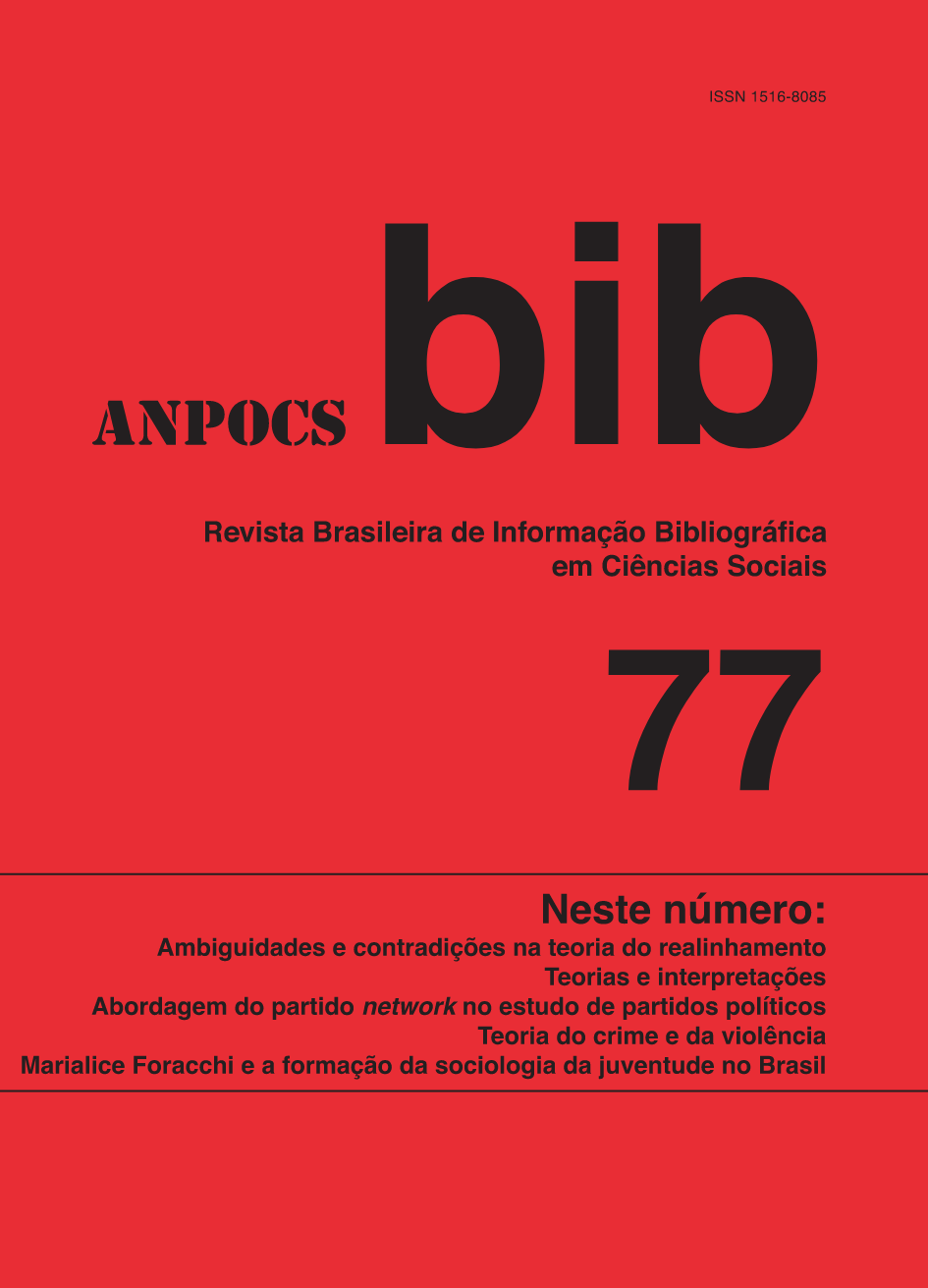Teorias do crime e da violência
uma revisão da literatura
Palavras-chave:
Crime, Criminalidade, Violência, Delinquência , TeoriasResumo
Existem muitas teorias que tentam explicar as causas da violência, com algumas se tornando referência em estudos elaborados em importantes escolas criminológicas, como a Escola de Chicago. Neste trabalho discuto algumas das principais teorias explicativas da criminalidade, delinquência e violência, e o objetivo central do artigo é trazer uma revisão da literatura, sobretudo a internacional, destacando desde teorias sociais do crime e da violência, como a teoria do aprendizado social desenvolvida por Edwin Sutherland no início do século passado, até as teorias econômicas baseadas num cálculo estratégico do ator criminoso, como a Teoria da Escolha Racional e a Broken Windows, que tiveram em autores como Gary Becker, James Wilson e George Kelling produções importantes com base em teorias racionais do crime e da violência.
Downloads
Referências
LEES-SMITH, M. A. The time-table of the house of commons. Economica, v. 11, p. 140-162, 1924.
LESTON-BANDEIRA, C. Da legislação à legislação: O papel do parlamento português. Lisboa: Imprensa de Ciências Sociais, 2002.
MAMADOUH, V.; RAUNIO, T. The committee system: powers, appointments and report allocation. Journal of Common Market Studies, v. 41, n. 2, p. 333-351, 2003.
MARTIN, A. Stabilite gouvernementale et rationalisation du regime parlementaire espagnol. Revue Française de Droit Constitutionnel, v. 41, n. 1, p. 27-66, 2000.
McKELVEY, R. D. Intransitivities in multidimensional voting models and some implications for agenda control. Journal of Economic Theory, v. 12, n. 3, p. 472-482, 1976.
MAYHEW, D. R. Congress: the electoral connection. New Haven: Yale University, 1974.
______. Divided we government: Party control, lawmaking, and investigations, 1946-1990. Yale: Yale University, 1991.
NEGRETTO, G. L. Making constitutions: Presidents, parties, and institutional choice in Latin America. Cambridge: Cambridge University, 2013.
NORRIS, P. The puzzle of constituency service. Journal of Legislative Studies, v. 3, n. 2, p. 29-49, 1997.
RASCH, B. E. Parliamentary voting procedures. In: DORING, H. Parliaments and majority rule in Western Europe. New York: St. Martin’s, 1995, p. 488-527.
______. Parliamentary floor voting procedures and agenda setting in Europe. Legislative Studies Quarterly, v. 25, n. 1, p. 3-23, feb. 2000.
REBUFFA, G. Teoria e prassi del negoziato parlamentare tra conflitto e consociazione. In: VIOLANTE, L. (org.). Annali della Storia d’Italia. Il Parlamento. Torino: Einaudi, 2001, p. 485-517.
REDLICH, Josef. The procedure of the house of commons: A study of its history and present form. London: Archibald, 1908-2004.
REDSLOB, R. Le régime parlementaire. Etude sur les institutions d’Angleterre, de Belgique, de Hongrie, de Suède, de France, de Tchécoslovaquie, de l’Empire Allemand, de Prusse, de Bavieère et d’ Austriche. Paris: Giard, 1924.
RIKER, W. H. Implications from the disequilibrium of majority rule for the study of institutions. American Political Science Review, v. 74, n. 2, p. 432-446, 1980.
RIVERS, D.; FIORINA, M. P. Constituency service, reputation, and the incumbency advantage. In: FIORINA, M. P.; RHODE, D. W. (Org.). Home style and Washington work. Ann Arbor: University of Michigan, 1991, p. 17-45.
RIVOSECCHI, G. Regolamenti parlamentari e forma di governo nella XIII legislatura. Milano: Giuffre, 2002.
ROHDE, D. W. Parties and leaders in the post-reform house. Chicago: University of Chicago, 1991.
SAIEGH, S. M. Political prowess or ‘‘lady luck’’? Evaluating chief executives’ legislative success rates. The Journal of Politics, v. 71, n. 4, p. 1342-1356, Oct. 2009.
SOUZA, M. T. O processo decisório na Constituição de 1988: Práticas institucionais. Lua Nova, v. 58, p. 37-59, 2003.
SCHICKLER, E. Disjointed pluralism. Princeton: Princeton University, 2001.
SHAW, M. Parliamentary committees: A global perspective. Journal of Legislative Studies, v. 4, n. 1, p. 225-251, 1998.
SHEPSLE, K. A. Institutional arrangements and equilibrium in multidimensional voting models. American Journal of Political Science, v. 23, n. 1, p. 27-59, 1979.
_______. The positive theory of legislative institutions: an enrichment of social choice and spatial models. Public Choice, v. 50, p. 135-179, 1986a.
_______. Institutional equilibrium and equilibrium institutions. In: WEISBERG, H. F. (ed.). Political science: the science of politics. New York: Agathon, 1986b, p. 51-82.
_______. The changing textbook congress. In: CHUBB, J.; PETERSON, P. (ed.). Can the government govern? Washington: Brooking Institutions, 1989, p. 238-266.
SHEPSLE, K. A.; WEINGAST, B. Uncovered sets and sophisticated voting outcomes with implications for agenda institutions. American Journal of Political Science, v. 28, n. 1, p. 49-74, 1984.
_______. The institutional foundations of committee power. American Political Science Review, v. 81, n. 1, p. 85-104, 1987.
SINCLAIR, B. Unorthodox lawmaking. Washington: CQ, 2000.
SHUGART, M. S. The Inverse relationship between party strength, and executive strength: a theory of politicians constitutional choices. British Journal of Political Science, v. 28, n. 1, p. 1-29, 1998.
TSEBELIS, G. Veto players: How political institutions work. Princeton: Princeton University, 2001.
TSEBELIS, G.; RASCH, B. E. Governments and Legislative agenda setting: An introduction. In:______. The role of governments in legislative agenda setting. New York: Routledge, 2011, p. 1-20.
TULLOCK, G. Why so much stability? Public Choice, v. 37, n. 2, p. 189-204, 1981.
WEHNER, J. Assessing the power of the purse: An index of legislative budget institutions. Political Studies, v. 54, p. 767-785, 2006.
WEINGAST, B. R.; MARSHALL, W. The industrial organization of congress. Journal of Political Economy, v. 96, n. 1, p. 132-163, 1988.
ZUBEK, R. Negative agenda control and Executive-Legislative relations in East Central Europe, 1997-2008. The Journal of Legislative Studies, v. 17, n. 2, p. 172-192, 2011.





